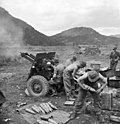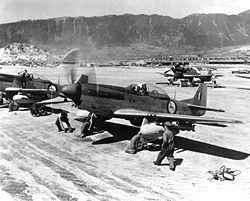First Battle of Maryang San
The Battle of Maryang San was Australia's greatest accomplishment in the Korean War.[1] The battle occurred when the US General George Fleet called for forces to capture some positions just before the signing of the truce at Panmanjan.[1][2]
Background
The Commonwealth forces, fighting as part of the United Nations were British, Australian and New Zealand units. These included three Battalions of the 28th British Commonwealth Brigade, the 1st Battalion The King's Own Scottish Borderers, 1st Battalion King's Shropshire Light Infantry and 3rd Battalion, Royal Australian Regiment. Brigadier George Taylor (United Kingdom) was the Brigade Commander. The British Commonwealth Division had the 25th, 28th and 29th Brigades under the command of Lieutenant General James "Gentleman Jim" Cassels (later Field Marshal Sir James) and was part of 1 Corps. These units were against the Chinese Communist forces. 3 Battalion RAR was commanded by Lieutenant Colonel 'Frank' Francis Hassett. Commonwealth forces main aims were to take a number of hill positions, and the main objective, Maryang San.
The first attacks saw the Australian A and B company of 3 RAR take Hill 199, and the 1st Battalion Kings Shropshire Light Infantry take Hill 208. The Kings Own Scottish Borderers had moved to take Hill 399 but were pinned down on its slopes by night time. The Australians attacked at dawn, moving against the Chinese held Hill 200. Chinese infantry were driven from their trenches, and they fled, leaving behind some prisoners of war. The first gun emplacement was taken, and then the second, with the Chinese troops retreating down the slope of Hill 200.
A, B and D Companies attacked the Chinese units, and drew them away from Maryan San, the main objective. Following United Nations forces artillery and mortar fire, Chinese troops withdrew from Maryan San, and the Australian troops moved to take the position. Australian troops moved against an area that was used by the Chinese for artillery bombardments, known as the Hinge. After taking the Hinge, they were subjected to constant attacks, which eventually became sporadic and died off. At about 8 pm, the Chinese launched an attack in huge numbers. The Australian units were well dug in, using the Chinese own trench positions, and responded to the waves of Chinese troops with machine gun fire. Chinese troops fell in their hundreds. South Korean porters moved forward constantly, bringing supplies and taking away wounded.
By 5 November, after the Australians were withdrawn to recover, Maryang San had been recaptured by the Chinese. It was a terrible blow to morale for those who had fought long and hard to capture it. The tactically important ground of Maryang San remained in the hands of Chinese forces for the rest of the war.
First Battle Of Maryang San Media
A British Centurion tank similar to those used at Maryang San
New Zealand gunners firing a 25-pounder in Korea
No. 2 Squadron SAAF Mustang fighters during the Korean War
Australian Vickers machine-gunners firing in support of the assault by C Company 3 RAR on Hill 317.
Australian casualties being evacuated during Operation Commando, October 1951
References
- ↑ 1.0 1.1 "Maryang San/"Operation Commando" - October 5-8, 1951". Archived from the original on 2008-08-28. Retrieved 2011-10-12.
- ↑ http://www.kmike.com/oz/kr/chapter8.htm
Further reading
- Breen, Bob (1994). The Battle of Maryang San: 3rd Battalion, the Royal Australian Regiment, 2–8 October 1951 (Second ed.). Georges Heights, New South Wales: Headquarters Training Command, Australian Army. ISBN 0642213089.
- (in Chinese) Chinese Military Science Academy (2000). History of War to Resist America and Aid Korea (抗美援朝战争史). Vol. III. Beijing: Chinese Military Science Academy Publishing House. ISBN 7801373901.
- Coulthard-Clark, Chris (2001). The Encyclopaedia of Australia's Battles (Second ed.). Crows Nest, New South Wales: Allen and Unwin. ISBN 1865086347.
- Grey, Jeffrey (1988). The Commonwealth Armies and the Korean War: An Alliance Study. Manchester, England: Manchester University Press. ISBN 0719027705.
- Hermes, Walter (1966). United States Army in the Korean War: Truce Tent and Fighting Front. Washington D.C.: Center of Military History, US Army. ISBN 0160359570.
- Horner, David, ed. (1990). Duty First: The Royal Australian Regiment in War and Peace (First ed.). North Sydney, New South Wales: Allen and Unwin. ISBN 004442227X.
- Horner, David, ed. (2008). Duty First: A History of the Royal Australian Regiment (Second ed.). Crows Nest, New South Wales: Allen and Unwin. ISBN 9781741753745.
- Johnston, William (2003). A War of Patrols: Canadian Army Operations in Korea. Vancouver, British Columbia: UBC Press. ISBN 0774810084.
- Kuring, Ian (2004). Redcoats to Cams: A History of Australian Infantry 1788−2001. Loftus, New South Wales: Australian Military Historical Publications. ISBN 1876439998.
- MacDonald, Callum (1986). Korea: The War Before Vietnam. New York City, New York: The Free Press. ISBN 0029196213.
- Malkasian, Carter (2002). A History of Modern Wars of Attrition. Westport, Connecticut: Praeger Publishers. ISBN 0275973794.
- O'Neill, Robert (1985). Australia in the Korean War 1950−53: Combat Operations. Vol. II. Canberra, Australian Capital Territory: Australian War Memorial. ISBN 0642043302.
- Zhang, Shu Guang (1995). Mao's Military Romanticism: China and the Korean War, 1950–1953. Lawrence, Kansas: University Press of Kansas. ISBN 0700607234.
Coordinates: 38°8′6″N 126°55′15″E / 38.13500°N 126.92083°E








